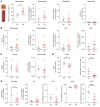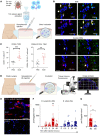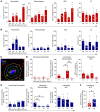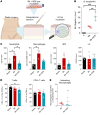Tick feeding modulates the human skin immune landscape to facilitate tick-borne pathogen transmission
- PMID: 36166299
- PMCID: PMC9621130
- DOI: 10.1172/JCI161188
Tick feeding modulates the human skin immune landscape to facilitate tick-borne pathogen transmission
Abstract
During cutaneous tick attachment, the feeding cavity becomes a site of transmission for tick salivary compounds and tick-borne pathogens. However, the immunological consequences of tick feeding for human skin remain unclear. Here, we assessed human skin and blood samples upon tick bite and developed a human skin explant model mimicking Ixodes ricinus bites and tick-borne pathogen infection. Following tick attachment, we observed rapidly occurring patterns of immunomodulation, including increases in neutrophils and cutaneous B and T cells. T cells upregulated tissue residency markers, while lymphocytic cytokine production was impaired. In early stages of Borrelia burgdorferi model infections, we detected strain-specific immune responses and close spatial relationships between macrophages and spirochetes. Preincubation of spirochetes with tick salivary gland extracts hampered accumulation of immune cells and increased spirochete loads. Collectively, we showed that tick feeding exerts profound changes on the skin immune network that interfere with the primary response against tick-borne pathogens.
Keywords: Adaptive immunity; Immunology; Skin.
Conflict of interest statement
Figures







Similar articles
-
Pathogen transmission in relation to duration of attachment by Ixodes scapularis ticks.Ticks Tick Borne Dis. 2018 Mar;9(3):535-542. doi: 10.1016/j.ttbdis.2018.01.002. Epub 2018 Jan 31. Ticks Tick Borne Dis. 2018. PMID: 29398603 Free PMC article. Review.
-
Adaptive immunity in Mus musculus influences the acquisition and abundance of Borrelia burgdorferi in Ixodes scapularis ticks.Appl Environ Microbiol. 2024 Dec 18;90(12):e0129924. doi: 10.1128/aem.01299-24. Epub 2024 Nov 6. Appl Environ Microbiol. 2024. PMID: 39503497 Free PMC article.
-
The abundance of the Lyme disease pathogen Borrelia afzelii declines over time in the tick vector Ixodes ricinus.Parasit Vectors. 2017 May 25;10(1):257. doi: 10.1186/s13071-017-2187-4. Parasit Vectors. 2017. PMID: 28545520 Free PMC article.
-
Differential expression of Ixodes ricinus salivary gland proteins in the presence of the Borrelia burgdorferi sensu lato complex.J Proteomics. 2014 Jan 16;96:29-43. doi: 10.1016/j.jprot.2013.10.033. Epub 2013 Nov 2. J Proteomics. 2014. PMID: 24189444
-
Changing the Recipe: Pathogen Directed Changes in Tick Saliva Components.Int J Environ Res Public Health. 2021 Feb 12;18(4):1806. doi: 10.3390/ijerph18041806. Int J Environ Res Public Health. 2021. PMID: 33673273 Free PMC article. Review.
Cited by
-
Bulk and single-nucleus RNA sequencing highlight immune pathways induced in individuals during an Ixodes scapularis tick bite.Infect Immun. 2023 Nov 16;91(11):e0028223. doi: 10.1128/iai.00282-23. Epub 2023 Oct 17. Infect Immun. 2023. PMID: 37846980 Free PMC article.
-
Single cell immunophenotyping identifies CD8+ GZMK+ IFNG+ T cells as a key immune population in cutaneous Lyme disease.bioRxiv [Preprint]. 2025 Jun 12:2025.06.09.658661. doi: 10.1101/2025.06.09.658661. bioRxiv. 2025. PMID: 40661371 Free PMC article. Preprint.
-
Tick extracellular vesicles in host skin immunity and pathogen transmission.Trends Parasitol. 2023 Oct;39(10):873-885. doi: 10.1016/j.pt.2023.07.009. Epub 2023 Aug 16. Trends Parasitol. 2023. PMID: 37591719 Free PMC article. Review.
-
Characterization of spatial lipidomic signatures in tick-bitten guinea pig skin as a model for host-vector-pathogen interaction profiling.mSystems. 2023 Dec 21;8(6):e0092723. doi: 10.1128/msystems.00927-23. Epub 2023 Oct 24. mSystems. 2023. PMID: 37874165 Free PMC article.
-
Hitchhiker's Guide to Borrelia burgdorferi.J Bacteriol. 2024 Sep 19;206(9):e0011624. doi: 10.1128/jb.00116-24. Epub 2024 Aug 14. J Bacteriol. 2024. PMID: 39140751 Free PMC article. Review.
References
-
- European Centre for Disease Prevention and Control and European Food Safety Authority. Tick maps. https://www.ecdc.europa.eu/en/disease-vectors/surveillance-and-disease-d... Updated 13 April 12, 2022. Accessed August 25, 2022.

